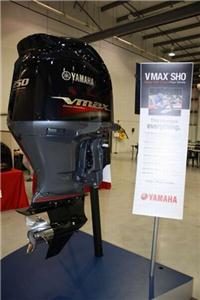
Yamaha's VMAX SHO will come in 250, 225 or 200 horespower. It's expected to be on the market ein January or February of 2010.
photo by Richard Simms
BRIDGEPORT, Ala. - Fancy promotions and advertising hype don't mean squat if the product doesn't produce.
No doubt, that skepticism ran rampant in the melons of many of the gathered boating and fishing media Monday night at The Chattanoogan. That's when the Yamaha Marine Group unveiled its highly-touted "game changer" series of 4-stroke outboard engines along with other innovations and tweaks designed to provide more reliability, efficiency and performance.
How many of these media guys, I wondered, have heard this before? How many in the course of 25-30 years have heard how great this boat will be or how super that outboard will be? It's the nature of the beast - the beast being the media - to be skeptical of such puffery until they can get their dirty little mitts on something to test it or play with it or try it out.
Tuesday at the Yamaha super-secret test lab here in this riverside community, the boating journalists got to see what all the fuss was about.
(A quick historical aside: Bridgeport was the site of a battle in the War of Northern Aggression (also known by a few as the Civil War) when the DamnYankees overtook the Rebs at Battery Hill near the Tennessee River. Bridgeport was a main site on the river, which was smaller then, for the Memphis-to-Chattanooga corridor and important in the war effort. A really fine re-enactment and rendezvous is held in the city each March.)
"Pay attention to the holeshot and the acceleration all the way through," said 2008 Bassmaster Classic champ Alton Jones as we idled out past safety buoys. The affable Texan was one of three Yamaha pro bass anglers on hand, joining Dean Rojas of Arizona and Dave Wolak of North Carolina.
Behind the wheel
Jones was piloting the new Skeeter FX20, which had the new Yamaha VMAX SHO 225 hanging on the back. Both were designed in a marriage of R&D happiness, with the boat's hull re-created to assist with the VMAX's controlled power. Jones floored the HotFoot and the VMAX rumbled. Then the FX20 bow lifted, fell and it climbed on plane within seconds.
Thundering upriver against a raging current, for the Tennessee Valley Authority was sending some serious water downstream, the FX20 never missed a beat. Jones let off the throttle and I figured the stern would sink, as all boats do. The boat lowered - not in a lurch, but seemingly just settled to the water - and then he punched it again. We went from about 57 or 58 mph back to 65 mph and climbing without a hiccup.
Then it was my turn. I goosed the throttle a few times, trying the holeshot. Nary a whimper. I left the VMAX trimmed down and floored it, and we cruised along about 46 mph. Jones said to trim it all the way up, then bump it down a couple of notches "and you'll probably get the best results."
Trim trim trim ... speed speed speed. We hit 75.6 mph and maintained that until I let off near the end of the run. Granted, this is a boat with only a full tank of fuel and two not-so-small men in the seats. But still ... the performance was there just as they said. Lift and scoot from the holeshot. Sustained acceleration without feeling like it was struggling through RPMs or trying to get to another level. Smoothness and speed, along with a comfortable ride in the FX, as expected.
Design was fun
Ben Jarrett of Skeeter said the boat was "a joy to design" because for once, they were able to do it in concert with the outboard during its production. They started with computer and foam prototypes, then modified and tinkered and shaved here and there to refine the previous iClass and other models into the FX.
For Skeeter guys, they may quickly notice the rear end and the pad is a little different. Both are designed to put more water in the center rear for the outboard propeller. The FX is wider in the middle, which Jarrett says gives more water-displacement underneath in the wider hull, which has sharper chines that assist with moving water out and away.
About 1.7 cubic feet of buoyant foam has been added in the rear sponsons for extra floatation. The engine hangs on a redesigned mount that has an internal brace fitted with two "knees" as Jarrett put it, that are attached to horizontal braces running through the hull stringers. The outboard's torque is then transmitted through those and that helps lift the rear of the boat, along with the foam, which in concert with the new pad and hull design gives the engine a better foundation of water in which to dig and go.
It all makes sense.
It also costs a pretty penny - about $67,937, which isn't the highest price in the new Yamaha-Skeeter marriage. The FX21 with the VMAX SHO 250 is $70,810. Skeeter says its high-performance, high-dollar boats have been in demand and they're prepared to keep going with both.
The product met the hype and produced. We'll find out in a few months if that demand will continue.
- Alan Clemons